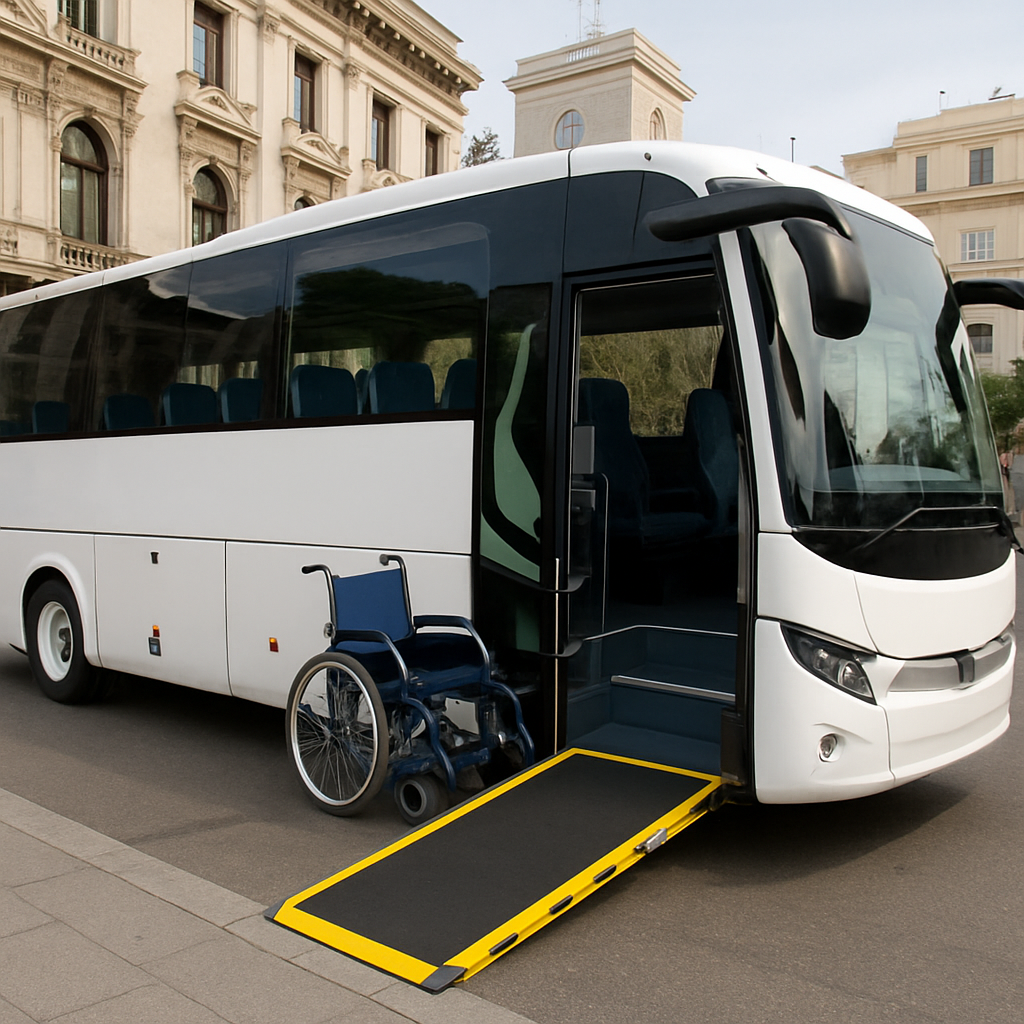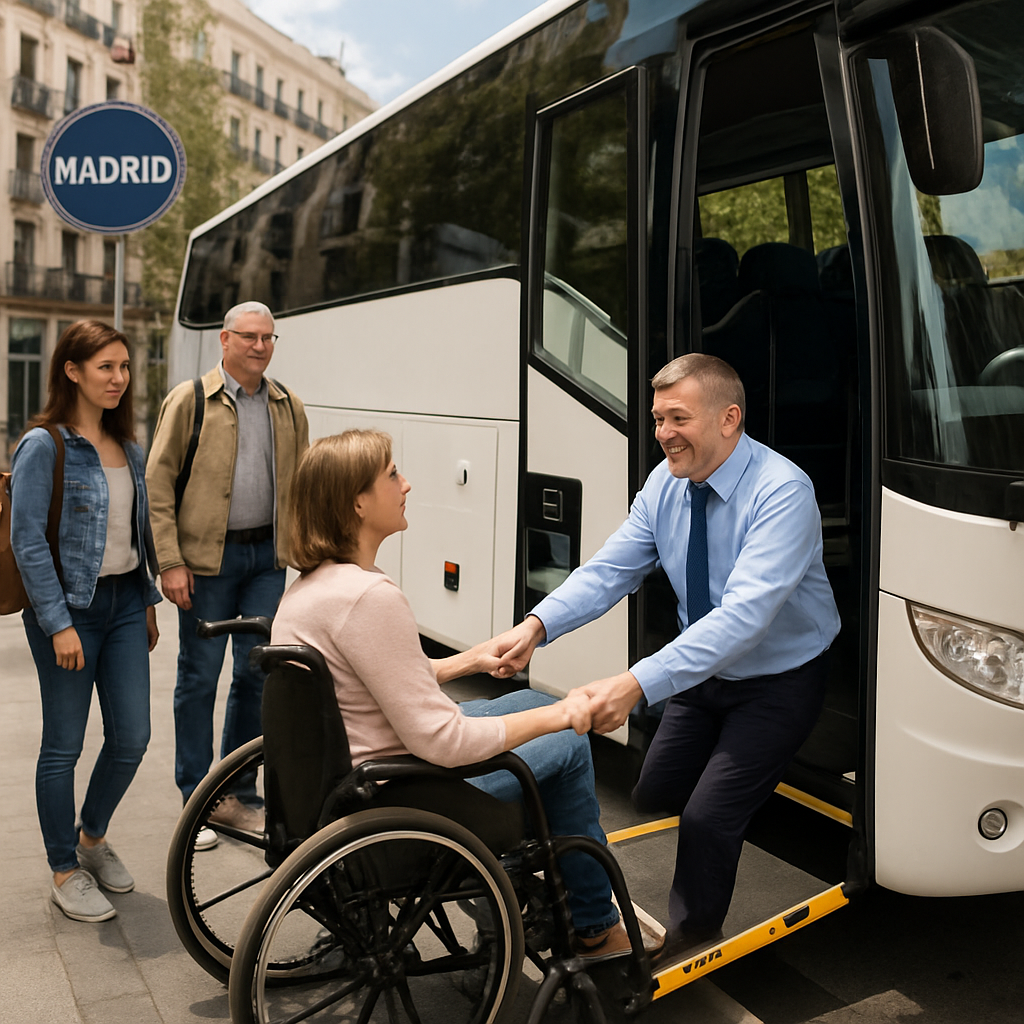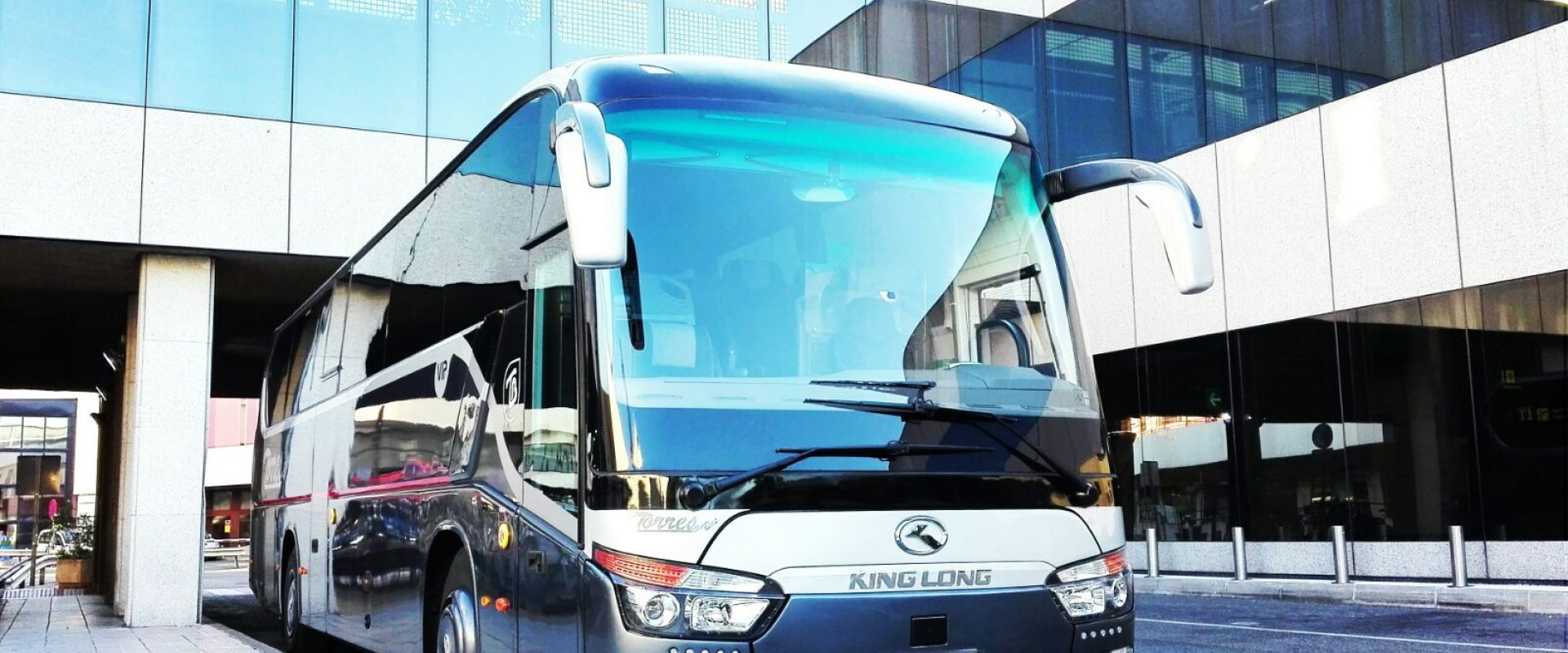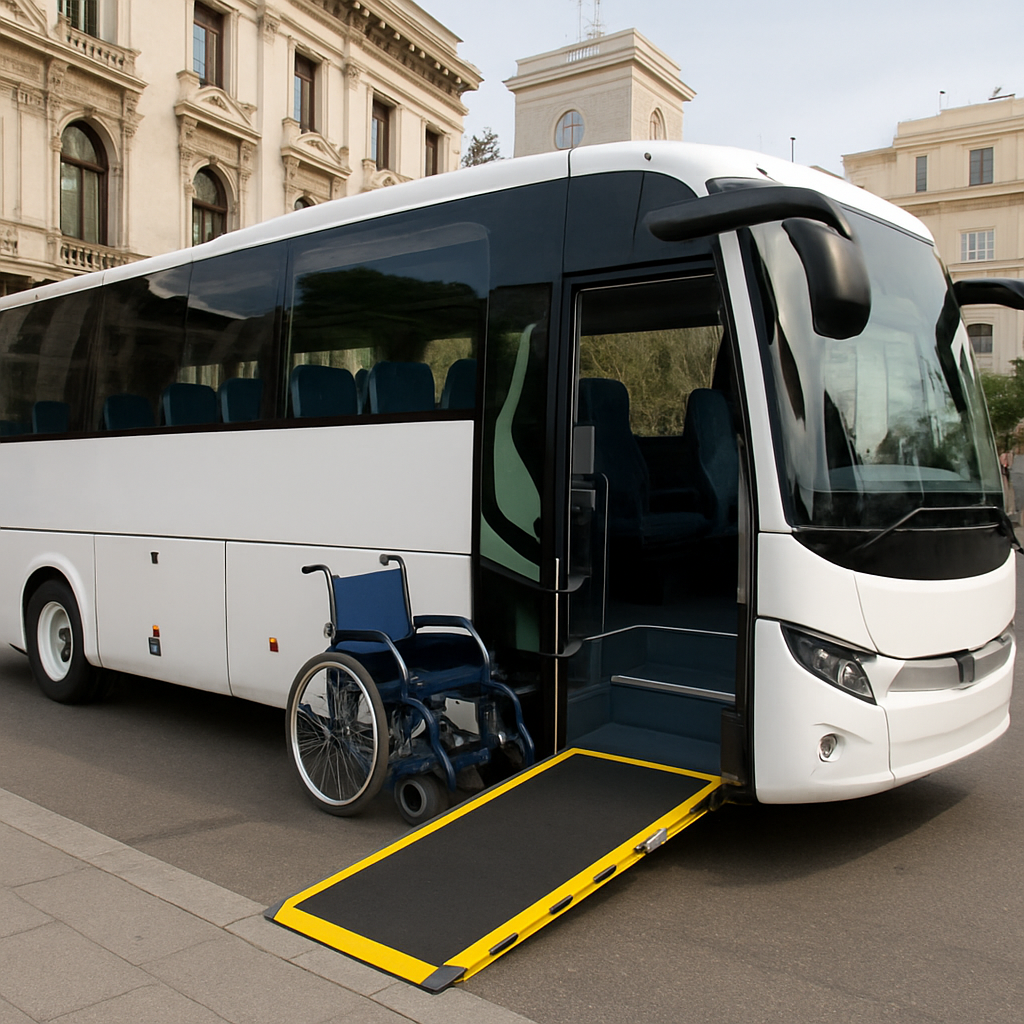Here’s a truth that might resonate: finding the right transport for everyone in your group can feel like juggling flaming torches. Especially when someone needs wheelchair access. You want the trip to be smooth, safe, and—let’s be honest—stress-free. But how do you make sure the coach you hire in Madrid ticks all those boxes?
That’s where a solid guide to wheelchair accessible coach hire in Madrid steps in. It’s not just about booking any bus; it’s about understanding what accessibility really means on the road—ramps, enough space, safety features, and respectful service. It’s easy to get overwhelmed with choices or worry if the vehicle suits your specific needs. You’re not alone if you’ve felt this way.
Think about it: a group outing organized perfectly, everyone arriving together, no one left behind because the vehicle wasn’t suitable. That’s the goal. And it’s absolutely doable once you know what questions to ask and what details to look for. Whether it’s a cultural trip, a corporate event, or a family gathering, having coach transport that genuinely accommodates everyone changes the whole experience.
Maybe you’ve booked coaches before but never with accessibility in mind. Or perhaps this is your first time navigating the jargon of ‘PMR compliant’ vehicles and wondering how to book one without confusion. What really matters is that you end up with a provider who gets it. Who prioritizes comfort, punctuality, and personalized care.
In this guide, we’ll walk you through the essentials—from picking the right vehicle size to ensuring the ramps and interiors meet your needs. Plus, we’ll share practical tips for booking and what to expect on the day of travel. By the end, you’ll feel more confident handling your next group trip in Madrid, no matter the mobility requirements.
Ready to get started? Let’s dive into everything you need to know for a genuinely inclusive journey. And if you want to peek ahead, check out this comprehensive guide to wheelchair accessible bus hire Madrid for more detailed insights.
TL;DR
Booking wheelchair accessible coach hire in Madrid doesn’t have to be a headache. It’s about knowing what to look for—vehicle size, ramp access, and personalized service that fits your group’s unique needs.
With the right prep, your trip can be smooth, comfortable, and truly inclusive. Ready to make it happen?
Step 1: Understanding Wheelchair Accessible Coach Options in Madrid
Let’s be honest—you want a coach that doesn’t just get you from A to B but makes the journey comfortable and hassle-free. Especially when it comes to wheelchair accessible options in Madrid, the stakes feel higher. You’re not just booking transport; you’re ensuring everyone in your group feels included and looked after.
So, what should you keep in mind when exploring wheelchair accessible coach hire? First off, it’s about understanding the range of vehicles available and their specific accessibility features. Coaches in Madrid come in various sizes and adaptations—some offer rear or side ramps, others come with lifts, and the interior layout changes to fit different wheelchair dimensions and user needs.
Features that Make a Difference
Think about the ramp or lift: is it manual or hydraulic? How easy is it to use? A smooth, sturdy lift is a game-changer if you’ve ever struggled with bulky equipment or shaky ramps. Then there’s seating arrangement. Some coaches have flexible interiors allowing seats to be removed or folded away, creating enough space for multiple wheelchairs plus companion seats.
One thing people often overlook is how the wheelchair is secured during travel. Look for coaches equipped with certified wheelchair restraint systems. It’s not just a safety box to tick, it gives peace of mind knowing everyone stays secure, even on sharp turns or sudden stops.
Size and Capacity: More Than Just Numbers
Now, you might think “Hey, I just need a coach big enough to fit my group.” But it’s not only about capacity—it’s about balance. Wanting a huge coach might sound great, but a smaller, well-adapted minibus can be friendlier in narrow Madrid streets, more eco-friendly, and surprisingly comfortable.
Torres Bus, for example, offers options ranging from luxurious minibuses of 7 to 25 seats with wheelchair accessibility, all the way up to large coaches seating 50 or more. It’s all about matching the vehicle to your group’s needs—not just cramming people in and hoping for the best.
Booking and Communication: The Unsung Heroes
Here’s a nugget that’s easy to miss. After you book, the best providers proactively connect with you to confirm details and discuss specifics—handling your wheelchair, arrival times, any special assistance needed. This isn’t bureaucracy; it’s ensuring your trip isn’t derailed by last-minute surprises.
Alsa, one of Spain’s leading coach companies, highlights the importance of providing a valid phone number so they can confirm your booking and reach you if anything comes up. Arriving roughly 30 minutes before boarding helps everyone settle in stress-free. These little things? They add up.
What About Accessibility Rules and Restrictions?
Madrid’s wheelchair accessible coaches must comply with local laws, but there’s also practical limits to consider. Not every wheelchair fits every vehicle—dimensions, weight, and type (manual or powered) can affect boarding options.
It’s wise to check these details upfront and ask the provider specifically about your equipment. They’ll guide you on what’s possible and whether any extra help is available for stowing or boarding.
If you want a dependable rundown on the costs and benefits of these accessible vehicles, there’s a great resource exploring understanding the cost and benefits of renting adapted minibuses in Madrid. It’s packed with practical insights that’ll save you headaches.
By now, you might be wondering how to find the right provider who genuinely gets these nuances. That’s where a trusted local operator with decades of experience—say, Torres Bus—makes a big difference. They combine modern fleets with personalized service designed specifically for accessibility needs.
If you want to dive deeper into all your hiring options for accessible vehicles around Madrid, check out this comprehensive guide to wheelchair accessible bus hire Madrid. It breaks down vehicles, services, and booking tips so you can pick what works without guesswork.
Understanding these core options takes a bit of effort, but that’s the secret to travel that feels seamless and respectful of everyone’s needs. Next step? You’re ready to start matching options to your group’s plan—without surprises or compromise.

Step 2: Determining Your Group’s Needs and Accessibility Requirements
Alright, you’ve got a group—great! But here’s the thing: no two groups are exactly the same, especially when it comes to accessibility. You know that moment when you’re trying to figure out what everyone really needs, and suddenly it feels like decoding a secret language? Yeah, it’s tricky but absolutely manageable once you know what to ask.
First off, think about who’s traveling. Are there people using wheelchairs? Or maybe folks with limited mobility who can’t climb steep steps or long ramps? This isn’t just about the obvious, but also subtle things like whether someone gets dizzy quickly or needs space for medical equipment. You want to catch these details early because retrofitting a coach or scrambling to find alternate transport last minute? No thanks.
Start with a simple checklist or chat with your group. Ask questions like:
- How many wheelchair users are in your party?
- Are any passengers using electric wheelchairs or scooters that might require extra space or special ramps?
- Does anyone have limited upper body strength that might affect boarding?
- Are there sensory sensitivities or other needs that might require a quieter or more comfortable environment?
It sounds like a lot, but honestly, checking these boxes upfront saves you from the chaos later.
Next up, accessibility isn’t just about fitting wheelchairs. It’s about how people get on and off the coach, how safely they can sit, and if they have enough room for what they need. For example, some wheelchair accessible coaches have ramps that extend 1.2 meters or longer, making boarding way easier than those with just a lift. Depending on your group’s physical needs, you might lean toward a low-floor vehicle with gentle ramps instead of a high step coach.
Also, consider the number of seats versus space for mobility devices. If you cram too many people in, the boarding and seating can get complicated fast. A good operator, like Torres Bus, who has experience with different accessibility layouts, will help balance space and seating to suit your group perfectly.
Don’t forget the terrain and route, either. If your trip involves narrow streets or cobblestones (hello, some Madrid neighborhoods!), make sure your chosen vehicle handles that comfortably. Sometimes, you might need a smaller minibus with accessibility features rather than a big coach just for that reason.
Now, I’m guessing you’re thinking, “How do I confirm all these details with the provider so nothing’s left to chance?” Transparency is key. Share your checklist and group’s needs upfront. And don’t just rely on written specs—ask for photos or, better yet, a quick video walk-through of the actual vehicle.
This accessible transportation guide goes into great detail about what features to look for and questions to ask, especially for group travel. It’s a handy resource to get you thinking beyond just the basics.
And don’t forget, it’s perfectly okay to get a bit picky here. After all, this is about comfort, safety, and dignity for every single person in your group. A well-planned trip that respects these needs turns strangers into smiling travelers who want to do it all again.
So, the takeaway? Start by mapping out your group’s specific accessibility requirements in detail. Make a list, ask questions, and share that info with your coach hire company. It’s the best way to avoid surprises and ensure smooth, stress-free travel through Madrid.
Need inspiration on how to organize your questions and details? Check out resources like Disabled Travelers’ How-To Guide that breaks down everything from wheelchair dimensions to boarding preferences.
Step 3: How to Compare and Choose the Right Wheelchair Accessible Coach
Okay, so you’ve got your accessibility checklist nailed down and you know exactly what your group needs. Now, the real question: how do you sift through all the options to pick the right wheelchair accessible coach for your trip in Madrid?
It feels a little overwhelming, right? There’s a lot to juggle — space, comfort, reliability, and those essential accessibility features. Let’s break it down together and make this part easy.
Start With Your Group’s Priorities
First off, think about who’s coming along. Is everyone using wheelchairs? Are there any folks who need extra help boarding? How many seats do you need in total, including accessible spots?
Knowing these details upfront will shape everything else. For example, if your group includes electric wheelchairs, not all coaches can accommodate those due to weight or charging needs. And you’ll want to confirm the boarding method — ramps, lifts, or low-floor entry.
Compare Accessibility Features — Don’t Take Them for Granted
Accessibility can mean different things depending on the vehicle. Some coaches have wide doorways and smooth ramps; others rely on hydraulic lifts. Which one feels safer or simpler for your group?
Also check for secure wheelchair tie-down points inside the coach. Safety is non-negotiable here — the last thing you want is wheelchairs shifting mid-ride.
Keep in mind, the best coaches for accessibility often offer extra space for movement and seating flexibility. It’s not just about fitting the wheelchairs — it’s about giving everyone room to relax.
Comfort and Convenience Matter
Wheelchair accessibility is critical, but so is comfort. Look at the overall interior layout — headroom, aisle width, and seating type. Some coaches have plush seats with armrests, which can make a long day so much nicer.
And don’t forget additional features like onboard climate control. Madrid’s summers can get hot fast, so air conditioning isn’t a luxury; it’s a necessity.
Check the Coach Condition and Company Reputation
Ever hopped on a vehicle that felt like it might fall apart any second? Yeah, let’s avoid that.
When comparing options, ask for current photos or — better yet — a short video tour of the coach. You want to see exactly what your group will be riding in. This level of transparency is a lifesaver.
Also, look into the coach company’s reviews, especially from travelers who required accessible services. A company with over 30 years in Madrid like Torres Bus often has a good track record to back up promises.
Price Isn’t Everything — But It’s Still Important
Sometimes, you’ll see a coach that ticks all the boxes but costs a little more. And that’s okay. Think about it like shoes: would you want to walk all day in cheap ones that hurt, or invest in comfort that lasts?
That said, get detailed quotes that clearly break down what’s included. Are the driver’s wait times extra? What about mileage or special boarding assistance?
Ask everything upfront to avoid hidden fees that could turn your budget upside down.
Let’s Put This All In a Snapshot
| Feature | What to Look For | Why It Matters |
|---|---|---|
| Accessibility Equipment | Ramps or hydraulic lifts, wide doorways, secure wheelchair spots | Ensures safe and easy boarding plus secure travel |
| Coach Size & Seating | Adequate seats for all with room to maneuver | Comfort and accessibility without crowding |
| Comfort Features | Climate control, cushioned seats, smooth ride | Keeps everyone comfortable on longer trips or in hot weather |
| Condition & Reliability | Recent photos/videos, positive reviews, experienced company | Confidence that your transport won’t let you down |
| Pricing & Transparency | Clear quotes, no hidden fees, included services | Stay within budget and avoid surprises |
Now, you might wonder: where can I find trustworthy information about wheelchair accessible transport options in Madrid? Luckily, there’s some great insight out there — Handiscover’s guide to wheelchair accessible transportation in Madrid is an excellent resource to understand the city’s accessibility landscape fully.
If you want to dive deeper into what accessibility really looks like for different types of vehicles and travel groups, check out Accessibility.com’s transportation guide, which includes tips relevant for coach hire too.
So, what should you do next? Start calling or emailing companies like Torres Bus and get hold of those coach videos or detailed descriptions. Don’t be shy about asking exactly how they’ll accommodate your group’s unique needs.
Remember, this isn’t just about getting from point A to point B. It’s about making sure everyone in your group travels with dignity, ease, and a whole lot of comfort. And honestly, when you nail that, the whole trip feels so much better.
Step 4: Booking Process and Important Considerations for Accessible Coach Hire
So, you’ve narrowed down your options and you’re ready to lock in that accessible coach hire in Madrid. But hang on — booking more than just a seat isn’t quite like grabbing a ticket online for a quick trip. When it comes to accessible coach hire, it’s really about making sure every detail fits your group’s unique needs. You want the journey to be smooth, comfortable, and hassle-free, right?
First things first: reach out early. Trust me, booking accessible transport can need a little extra lead time. Companies need to make sure your coach has the right adaptations, like wheelchair ramps, spacious seating arrangements, and secure points for mobility devices. You don’t want to scramble last minute wondering, “Will this coach really work for us?”
Here’s a quick checklist to keep handy when you contact your provider (like us at Torres Bus):
- Your group size and the exact number of passengers who require wheelchair accessibility.
- The type and dimensions of any mobility devices or equipment (manual or powered wheelchairs — details matter).
- Whether any passenger needs assistance boarding or disembarking.
- Special requests like service animals, dietary needs for onboard meals, or space for extra equipment.
Don’t hesitate to ask the tough questions. For example, how does the company handle boarding? Are the lifts or ramps tested regularly? What’s the turnaround time if something unexpected happens? A transparent operator should welcome your questions because the goal is simple: your peace of mind.
Booking methods vary, but it often helps to start with a direct call or email. That personal touch opens up space to explain your group’s specific needs and helps avoid any surprises down the line. Some companies also offer online forms specifically for accessible transport requests — which is great as long as you double-check they follow up.
Oh, and one thing that gets overlooked? Confirmation details. Once you’ve booked, ask for a clear written summary outlining accessibility features, the driver’s contact info, pickup times, and step-by-step instructions tailored to your group. You want that info handy on the big day so nothing falls through the cracks.
Wondering how to balance cost and comfort? It’s tempting to jump at the cheapest option, but when it comes to accessibility, a little extra investment means avoiding headaches and ensuring everyone travels with dignity. If a quote doesn’t clearly spell out what’s included, push for clarity. Transparent pricing is non-negotiable, especially when your group depends on specific accommodations.
If you want some extra peace of mind, check out resources like the Amtrak Accessible Travel Services page. It offers a great example of how accessible travel reservations can be handled with care and attention, from booking to onboard services.
And for wider tips on what to look for in accessible travel, Accessibility.com’s transportation guide is a treasure trove, sharing practical advice that really hits home.
Bottom line? Booking accessible coach hire in Madrid isn’t just a transaction. It’s a commitment to making sure everyone on your trip can feel safe, comfortable, and included. By taking the time to ask the right questions, confirm details, and choose a company that truly understands accessibility, you’re already halfway there.
Ready to make your booking? Grab that phone, and don’t be shy about the details — they make all the difference.

Step 5: Accessibility Regulations and Standards for Coach Hire in Madrid
Booking a wheelchair accessible coach isn’t just about finding a van that fits the wheelchair. Believe me, there are rules and standards in place for a reason — to protect comfort, safety, and dignity for everyone on board.
In Madrid and across Spain, accessibility in transport follows strict regulations designed to make travel inclusive. These rules aren’t just paperwork; they’re your assurance that you’ll get a ride that’s genuinely accommodating.
So, what are these regulations all about?
At the core, Spain follows the Royal Decree 1544/2007, which sets out basic accessibility and non-discrimination standards for public transport. That means any coach service, including private hires like those from Torres Bus, must ensure their vehicles and services accommodate persons with reduced mobility (PMR). This includes wheelchair ramps, priority seating, visual and audio aids, and trained staff to assist.
But it doesn’t stop there. European laws like Regulation 1107/2006 reinforce rights for passengers with disabilities or reduced mobility in all air and road transport across the EU. So whatever coach you hire needs to meet these standards or go beyond them. It’s your right, after all.
Ever wondered what this means practically when you hire a coach?
First, the vehicle itself must have wheelchair lifts or ramps that meet safety rules. There should be secure wheelchair spaces with locking mechanisms for safety during transit. Next, your driver or assistant should be trained—not just in driving but in helping passengers with a gentle touch, patience, and respect.
For instance, Torres Bus keeps their fleet updated with these features and trains their drivers exactly for this. They follow guidelines to ensure the boarding and disembarking processes are smooth and dignified — no fumbling with equipment or rushed lifts that make anyone feel uncomfortable.
What about things like seat assignment and other services?
Accessibility regulations also insist that seating arrangements don’t discriminate, meaning passengers with reduced mobility get equal options, barring specific safety restrictions. Also, service dogs are a protected right and must be accommodated onboard free of charge, which is often overlooked but critical.
Plus, according to local laws, companies can’t charge extra fees solely because of a passenger’s mobility needs. So, if a wheelchair-accessible coach costs a bit more, it’s because of legitimate extra equipment, not unfair surcharges.
If you want to get serious about it, I recommend checking the European Commission’s Transport Accessibility resources which lay out clear expectations for transport operators. Knowing these lets you call out any company that doesn’t meet standards—and those that do, like Torres Bus, get your trust.
You might be thinking, «Sounds good, but how do I make sure my coach hire ticks all these boxes?»
Start by asking the company straight out about their compliance with local and European accessibility standards. Get specifics: What kind of wheelchair ramps do they use? Are their drivers certified to assist? Can they accommodate service animals? It’s okay to be a little picky here — this isn’t just a ride, it’s about respect and safety.
And here’s a quick tip: request to see or get documentation on their vehicle’s accessibility features and staff training records. Transparency is a good sign.
When everything aligns with the rules, you and your group can focus on the trip itself, not scrambling for accommodations. Accessibility regulations might sound like dry legal stuff, but they boil down to one thing — making sure your journey in Madrid is comfortable, respectful, and safe for all.
Conclusion
So, here we are—wrapping up this guide to wheelchair accessible coach hire in Madrid. If you’ve felt overwhelmed at any point, you’re not alone. Finding the right transport that respects your needs and those of your group can feel like navigating a maze.
But remember, it’s not just about finding any coach. It’s about securing a ride where accessibility is built-in, not an afterthought. When companies like Torres Bus prioritize comfort, safety, and clear compliance with accessibility standards, your trip turns from stressful to smooth. You can actually enjoy the city instead of worrying over logistics.
Think about it this way: the journey is just as important as the destination. So, don’t settle for less than what you deserve. Do your homework—ask the right questions, request documentation, and be upfront about your needs. It’s okay to be a bit picky here; your peace of mind is worth it.
And here’s a little secret: good accessibility isn’t just about physical ramps or lifts. It’s about respect, understanding, and a company’s willingness to go the extra mile.
So, what should you do next? Start your search with companies known for transparency and dedication. Reach out to Torres Bus, for example—they’re family-run with over 30 years of experience, and specialize in exactly this kind of tailored service.
At the end of the day, this guide is your starting point. Take it slow, ask questions, and remember—you deserve an easy, enjoyable ride through Madrid, accessible to all in your group.
Frequently Asked Questions about Wheelchair Accessible Coach Hire in Madrid
Let’s be honest, booking wheelchair accessible coach hire can feel like a bit of a headache, right? You want to get it right so everyone’s comfortable and safe, without the endless back-and-forth or hidden complications.
What makes a coach truly wheelchair accessible in Madrid?
Good question. It’s not just about having a ramp. A properly adapted coach includes wide doorways, secure spaces to lock wheelchairs in place, and enough room to move around without feeling cramped. Plus, thoughtful features like grab handles and low floors make a big difference.
And here’s the kicker—you want a company that knows the rules and follows them strictly. Accessibility standards aren’t a mere suggestion—they’re there to make sure no one’s sidelined.
How do I know if a company really understands accessibility?
You’ll want to ask direct, clear questions. Don’t hesitate to request photos or videos of the vehicle you’ll be using. And ask about their drivers too—are they trained to assist wheelchair users? Sometimes experience speaks louder than fancy brochures.
Can my entire group travel together comfortably with wheelchair-accessible coaches?
Absolutely. Accessible coaches often come in various sizes, from small minibuses to larger coaches, so there’s room for everyone. But the trick is to confirm layout options beforehand—sometimes making a quick call or sending an email clears up any doubts better than a dozen websites.
What if I need to book last minute?
It happens to the best of us. Some companies keep a few accessible coaches ready for emergencies, but it can be a gamble. The safer bet? Planning ahead if possible. The peace of mind knowing your transport is sorted just beats stress, every single time.
Is the booking process complicated for wheelchair-accessible coaches?
It shouldn’t be, but it can feel like it, especially if a company isn’t upfront about what’s included. Choose operators who are transparent and ask upfront about your needs: type of wheelchair, number of passengers, and any extra assistance required.
Torres Bus, for instance, makes this smooth by personalizing every trip—they get that it’s not one size fits all.
Do accessible coaches have extra costs?
Sometimes, yes. Specialized equipment and extra space might come with added fees. But don’t let that scare you off. What’s more important is value. Paying a bit more to avoid hassle or, worse, an unsafe ride? Totally worth it.
Remember, good accessible transport is an investment in dignity and comfort.
So, what’s the takeaway here? Don’t settle for vague promises. Ask, check, and insist on clarity. That’s how you’ll find a coach hire in Madrid that really works for you and your group—wheelchair users included.



